
Original Link: https://www.anandtech.com/show/1233
AOpen AK86-L UPDATE: Uncommonly Good
by Wesley Fink on March 30, 2004 1:00 PM EST- Posted in
- Motherboards
UPDATE 3/30/2004:
AOpen has made a number of changes to the AK86-L motherboard since our initial review. The board was an excellent performer with outstanding features for the price, but there were several areas that were suggested for improvement. Many of our suggestions regarding those feature improvements have been added to the board with BIOS updates. Almost all of the updated features are available on all AK86-L boards, but there is also a new revision to the board that adds additional options to vCore adjustment. All other features are available on all revisions of the board.AOpen has posted a special beta revision to the AK86-L on the AOpen download site. This is called Revision 1.08c Beta. Many of these added features are also incorporated into the latest release version 1.09. There will also likely be a further revision to 1.09 to incorporate adjustable CPU ratios in the 1.09 BIOS. Revised features of 1.08c Beta BIOS:
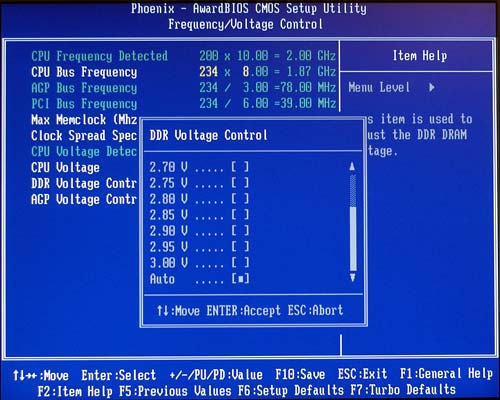
Adjustments for memory voltage have now been extended from 2.5V to 3.0v in 0.05v increments. This is an extremely wide and useful range for users trying to get the most from their memory.
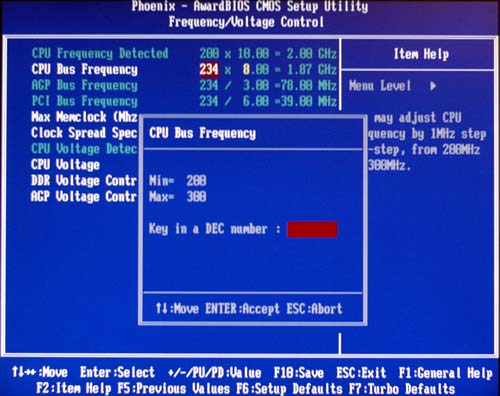
In the original shipping BIOS, FSB adjustment was only available to 255. In the 1.08c revision, FSB can now be adjusted from 200 to 300 in 1MHz increments.
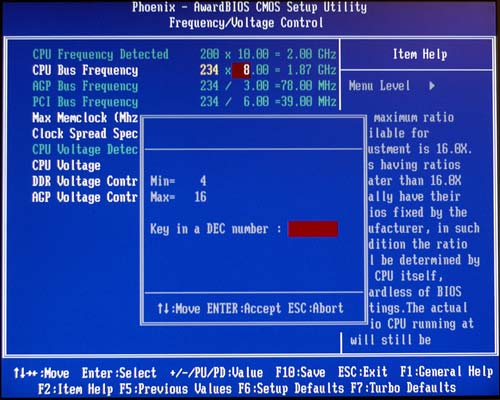
CPU ratios can be adjusted down in the 1.08c BIOS. Available ratios are from 4 to 16, but only values equal to or lower than the CPU shipping ratio will work. For example, the 3200+ has a ratio of 10 (10x200), so values of 10 and lower will work.
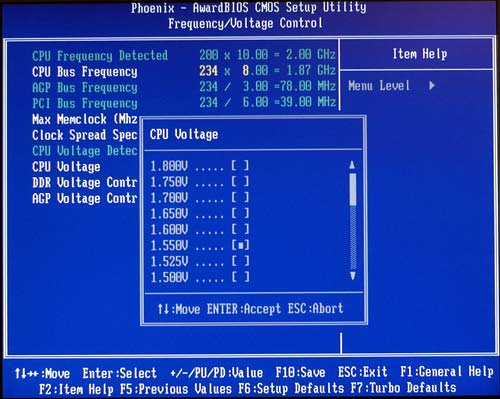
A new revision of the board has been released to allow a greater range of vCore settings. The new revision, which AOpen says is now in production, allows vCore to be adjusted from 0.8v to 1.8v in 0.05V increments. All revisions allow adjustment from 0.8v to 1.55v. The default voltage for a 3200+, for example, is 1.5v. We have not had much success overclocking Athlon 64 chips by increasing processor voltage with air cooling, but those with water or phase-change cooling will appreciate the added vCore options on the new revision of the AK86-L.
As stated in our review, the AK86-L is a fast and stable Socket 754 motherboard that represents outstanding value. With the recent changes, AOpen has certainly broken away from the pack in the value segment and deserves to be recognized as an AnandTech Editor's Choice.
 |
We are pleased to recognize the AOpen AK86-L with the AnandTech Editor's Choice as the best value in Socket 754 motherboards. At a price of about $100, the AOpen AK86-L offers genuine value for those building an Athlon 64 system. |
Almost all of the current Athlon 64 boards are limited in overclocking by the inability to fix the AGP/PCI bus. The AK86-L does not break new ground in that area, but the performance is very fast at stock speed and the available options are as good as you will find in almost any Athlon 64 board. The Shuttle AN50R and Gigabyte K8NNXP are currently the darlings of the serious overclocking community because they apparently do have working AGP locks and great FSB flexibility, but they cost a great deal more than the AK86-L. If you want the best overclocking available on current Athlon 64 boards then you should choose one of these motherboards. However, the AOpen with the new BIOS delivers standout speed at stock plus overclocking as good as you will see in a VIA chipset board for Socket 754.
AOpen is the components division of Acer, the huge company that has their hand in many consumer electronics markets. They produce motherboards, chipsets with their ALI brand, optical drives, displays, memory, and on and on. AOpen has produced motherboards for AMD processors almost from the time they were first introduced. Over the years, they have produced some very solid and interesting boards, but AOpen has never been very clear or consistent in their marketing direction. In the past year, AOpen produced some interesting boards for Intel chipsets and they have once again targeted the Enthusiast market. I say "once again" because AOpen seems to shift between hot and cold regarding whether or not the Enthusiast market matters to their sales. In the past, there have been some remarkably well-designed boards that were "almost there". In most cases, however, AOpen stopped short in development to truly raise the products to outstanding.
The AK86-L is AOpen's first Athlon 64 motherboard, supporting the mainstream Socket 754 processor and using the VIA K8T800 chipset. AOpen also produces the AK89 Max, which is based on the nVidia nForce3-150 chipset. While there are several models listed in both the AK86 and AK89 families, these two models are the only two that we have actually seen for sale. The "L" in the AK86-L means that Gigabit LAN is included.
AOpen AK86-L: Basic Features
| Motherboard Specifications | |
| CPU Interface | Socket 754 Athlon64 |
| Chipset | VIA K8T800/VIA VT8237 |
| Bus Speeds | 200MHz to 255MHz (in 1MHz increments) |
| PCI/AGP Speeds | None. BIOS reports AGP/PCI frequencies as FSB changes |
| Available CPU Ratios | CPU ratios below rated multiplier can be selected in the range of 4x - 16x |
| Core Voltage | Normal, 0.8V to 1.55 V in .025V increments |
| DRAM Voltage | Normal, 2.50V to 2.70V in 0.05V increments |
| AGP Voltage | 1.5V, 1.533V, 1.566V, 1.6V |
| Memory Slots | Three 184-pin DDR DIMM Slots Single-Channel Configuration Regular Unbuffered Memory to 2GB Total |
| Expansion Slots | 1 AGP 8X Slot 5 PCI Slots |
| Onboard Serial ATA RAID | VIA 8237 (2 Drives, 0, 1) |
| Onboard IDE | Two Standard VIA ATA133/100/66 (4 drives) |
| Onboard USB 2.0/IEEE-1394 | 8 USB 2.0 ports supported by 8237 No FireWire ports |
| Onboard LAN | Realtek RTL8110S Gigabit LAN |
| Onboard Audio | Realtek ALC655 codec AC '97 2.3 6-Channel with UAJ |
| BIOS Revision | 1.06M (2/03/2004) |

The packaging is a rather basic green on white, but the feature list is very extensive. For a motherboard selling at a bit less than $100, you get the full range of AOpen features, including SilentTek smart fan controller to lower system noise, EZWin Flash for BIOS updates from Windows, Watch Dog for recovering from bad overclocks, and the EzClock utility for overclocking while in Windows. AOpen includes the VIA RAID driver floppy that is needed for installing the OS with a SATA drive. Many manufacturers have started leaving this necessity out of the box - forcing the installer to find another PC to create the install floppy.

The AK86-L back panel options include 4 USB 2.0 ports, 3 individual mini jacks for audio, Gigabit LAN, PS2 mouse/keyboard ports, Parallel, and a single serial port. There are additional headers on the motherboard for a 2nd serial port and a game port, but brackets for the game and the 2nd serial are not included in the retail package.
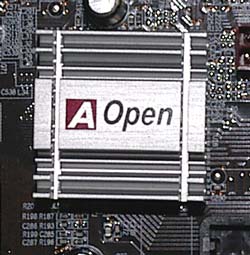
The VIA K8T800 is a traditional Northbridge/Southbridge chipset. A large passive heatsink is used on the Northbridge instead of an active solution used in other designs. However, we did not have any overheating problems in our benchmarking. The 8237 Southbridge has much less to do with the memory controller on the Athlon 64 chip, and does not provide any cooling. The Southbridge also remained cool during benchmarking.
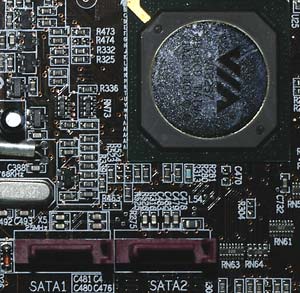
AOpen has included provisions for 2 SATA drives supported by the 8237, either regular SATA or SATA RAID 0 or 1.
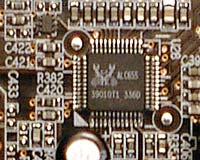
The AOpen AK86-L uses the Realtek audio codec called ALC655, which is compliant with the latest AC '97 Rev. 2.3. This audio codec features 6-channel sound and UAJ or Universal Audio Jack, with a better than 90db signal-to-noise ratio. This allows automatic jack programming as we've seen on some boards based on Intel's 865/875 chipsets. The ALC655 is quite similar to the Realtek premium ALC658 sound solution. Additional information and specifications are available at Realtek.
While an SPDIF bracket is not included in the AK86-L package, there is an SPDIF I/O header on the motherboard. In addition, there is an audio connection header with connector options and two connectors for Optical Drive audio cables. While the audio input and output options are very good, please keep in mind that you must find and put in additional brackets to use many of the audio options. The brackets are not part of the standard package.
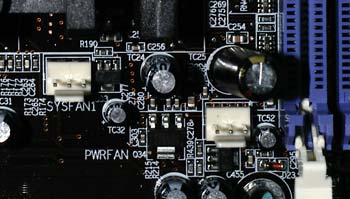
One of the first things that many manufacturers seem to eliminate when they build a $100 board is fan-headers. AOpen has a really effective smart fan control system and they also thoughtfully included five fan headers on the board - four 3-pin headers and one 2-pin temp header. Obviously, it occurred to someone in AOpen engineering that SilentTek was only useful if there were plenty of fan headers on the board. The large number of fan headers will be appreciated by anyone with multiple cooling fans.
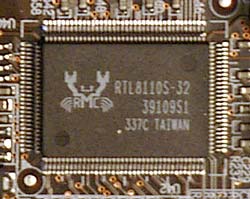
The AK86-L includes Realtek Gigabit LAN. LAN connections have moved from added cards to an on-board feature, and we now are starting to see Gigabit LAN become more common, even on boards designed for the mid-to-low price range. Dual color LEDs in the LAN socket indicate 10/100 or Gigabit operation.
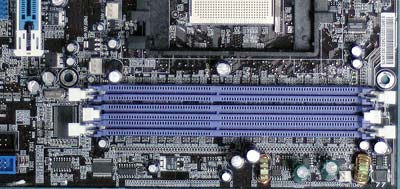
Three DIMM slots support standard unbuffered Single-Channel memory. AOpen claims support for up to 2GB of DDR400 memory in 2 DIMMs, and up to 3GB of DDR333 or slower memory in 3 DIMMs.
AOpen AK86-L: Board Layout
The AK86-L is the all-black that AOpen has used on most of their recent top boards. The board itself is a bit smaller than full-size, requiring just 6 stand offs for installation.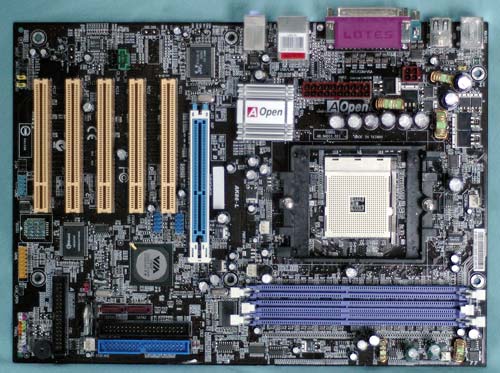
Layout of the board is generally very good, although there are a few concessions to the smaller motherboard size. As mounted in a typical tower case, the CPU socket is in the upper center of the board, with all power connectors to the left of the CPU and DIMM slots to the right.
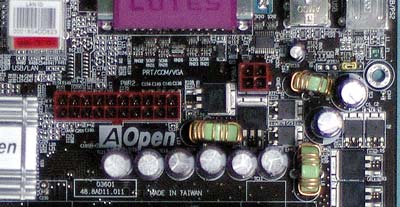
The Athlon 64 and FX51 boards use a standardized ATX plus 12V connector arrangement that is identical to the power connector requirements of current Pentium 4 systems. Generally, we prefer the connectors together on the upper right of the board, but AOpen has placed both the 20-pin ATX and 4-pin 12V together at the upper left of the board. This arrangement is acceptable in many cases, but it may require the bulky ATX cable to be routed around the CPU and this could interfere with CPU cooling in some case/power supply designs. We are more concerned that the large capacitors between the CPU socket and 20-pin ATX are in the way of releasing the 20-pin cable. It is hard to unlatch the 20-pin cable without pushing on the capacitors and risking damage. It is good to see AOpen use the large 3300µF capacitors for voltage stability, but more care needs to be paid to connector placement in relation to the large capacitors.
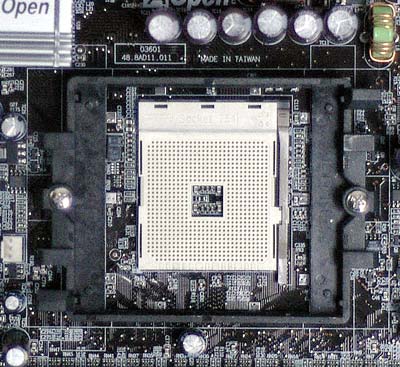
Despite all the tall capacitors around the CPU socket, we had no problem at all mounting the huge Zalman 7000 HSF or any other HSF that we had available. There is plenty of room around the CPU socket to mount most any cooler.
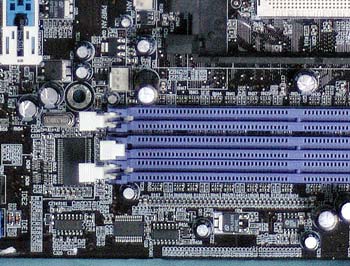
The DIMM slots are also clear and accessible, even when the largest CPU fan is installed. The DIMMs are well-spaced from the AGP slot, so there is no problem with the AGP card interfering with upgrading or changing memory.
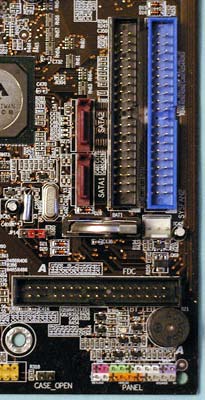
The Primary/Secondary IDE and floppy connectors are located on the lower right of the board. This will not be a problem in a standard mid-tower case, but it could be an issue in a full-tower case. We prefer an upper right location so that you don't have to worry about cable length in a full-tower case. Fortunately, all 3 connectors are on the right edge, so they do not interfere with other components on the board.
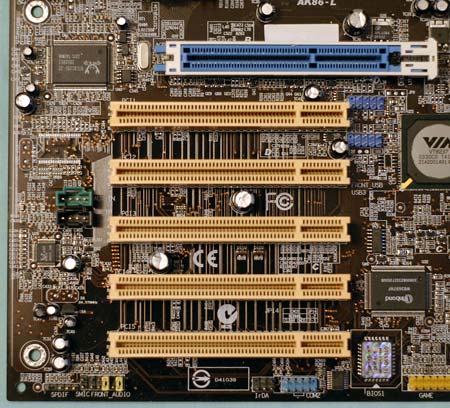
The AK86-L has 5 PCI slots and an 8X AGP slot that uses an easy-to-lock/unlock slide connector. The push-down connector on many AGP slots is hidden completely by high-end AGP cards, making release of a 9800 PRO or FX5900 more difficult than it needs to be. The slide lock used here is one of the easier-to-use arrangements that we have seen. The AGP slot is also protected by an LED at the end of the slot that will light if you install an unsupported video card using voltages higher than 1.5V.
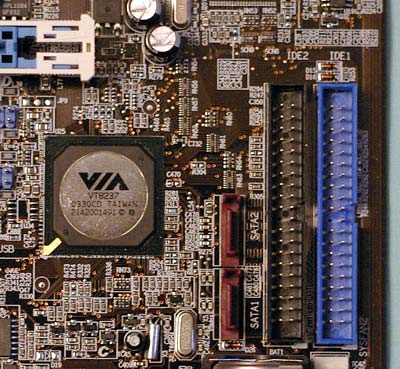
If you require a full-length PCI slot, you will have to use slot 4 or 5. SATA and IDE connectors will likely interfere with large PCI cards in slots 1-3.
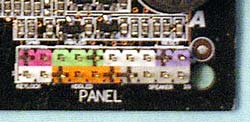
AOpen and several other manufacturers are now using color-coded connectors for the case connections. The color coding and clearly marked polarity make it a little easier to get the connections right the first time.
AOpen AK86-L: BIOS

The AK86-L uses the familiar Award BIOS. AOpen also includes a full set of tweak options, generally located under the Advanced Chipset Features and Frequency/Voltage Control tabs.
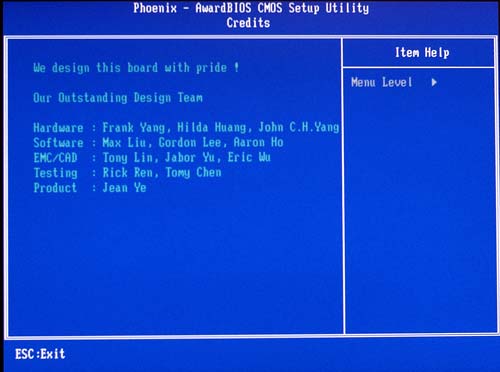
Recent AOpen BIOS has included a Credits tab where the people who developed the product are listed by name. It's a nice touch, and naming developers in the BIOS shows pride in the product.
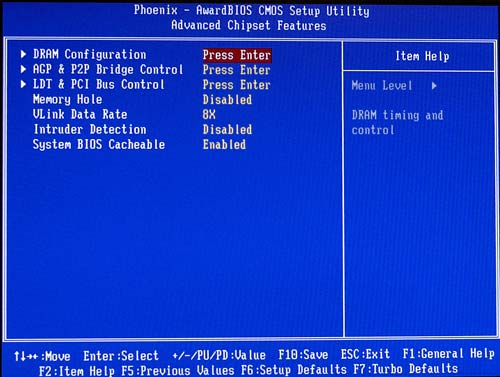
Advanced Chipset Features has submenus for DRAM and Hypertransport timings.
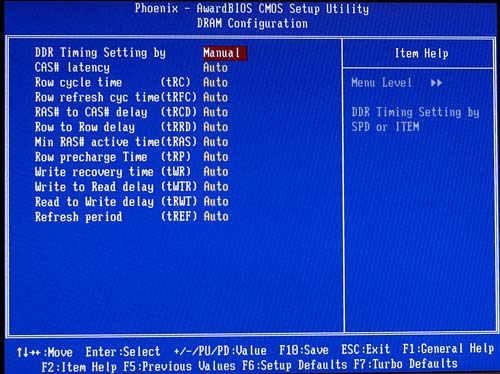
AOpen provides a very complete selection of memory timing adjustments in the DRAM submenu.
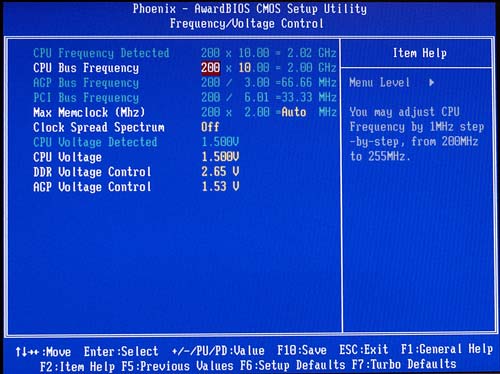
Frequency and Voltage adjustments are in this submenu. In addition, AOpen provides a readout on PCI and AGP frequencies. We were not surprised to see 33/66 at 200. Further testing with a PC Geiger showed that PCI/AGP was actually ratio-controlled, similar to what we have seen on Abit VIA K8T800 boards for Athlon 64.
Submenus in Frequency/Voltage Control allow a wide range of options.
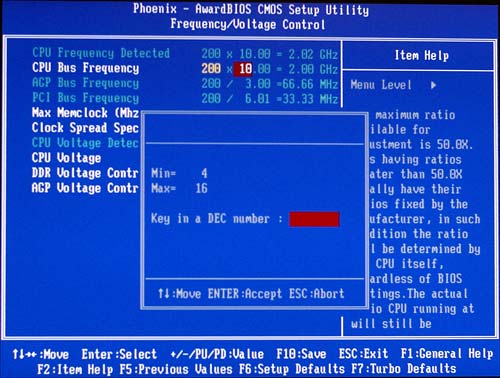
CPU multipliers below the rated speed can be selected in the BIOS. With a 3200+, the multiplier was 10, and we found values below 10 did work as selected. This capability means that the FSB adjustment to just 255 needs to be expanded by AOpen. We were able to reach 9x240 and 8x252 with our test 3200+ (10x200). With ratio adjustments, and ratio-driven PCI/AGP frequencies, you should be able to squeeze the most from high-speed memory with the AK86-L.
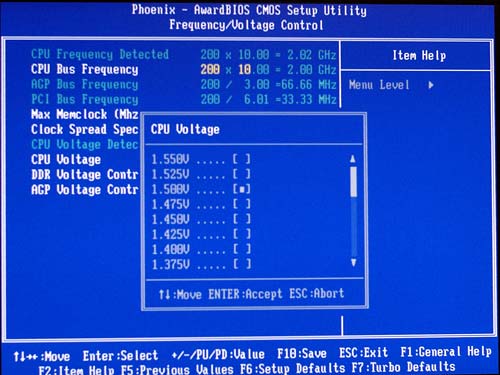
While CPU voltage can be adjusted from 0.8V to 1.55V, enthusiasts would prefer to see more voltage available on the top - to about 1.7V.
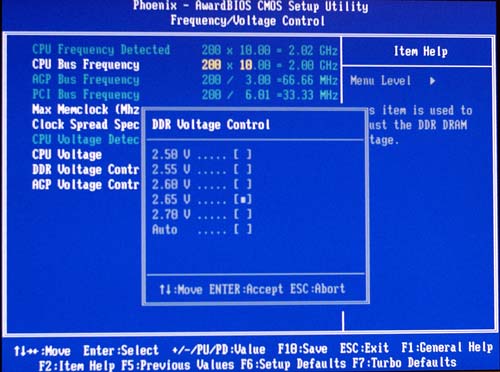
AOpen includes Memory Voltage adjustments from 2.5V to 2.7V in 0.05V increments. With some high-speed memory now warranting performance to 3.0V, this would be a better match to the other board capabilities with a wider range of memory voltage selections.
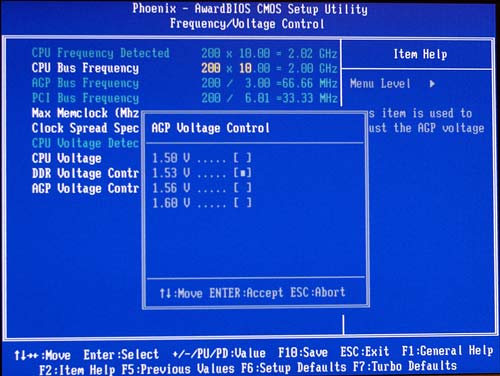
AGP voltage options are 1.5 to 1.6 in fine 0.033 increments.
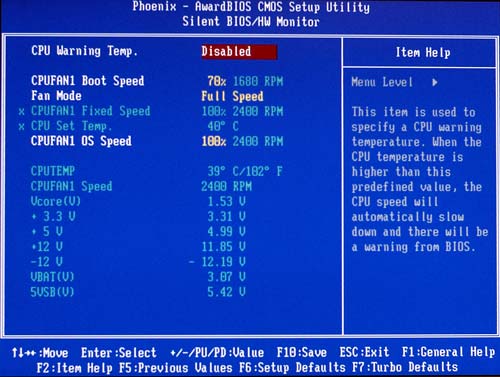
The AK86-L includes smart fan controls in the Silent BIOS/HW Monitor section. You will also find a complete report of voltages. Beginning with the 1.06M BIOS, AOpen reports that they have added the AMD Athlon 64 Cool n Quiet feature.
The tweaking options in the AK86-L BIOS are outstanding for a production BIOS. There is very little to complain about in the options that are offered. However, the memory voltage and CPU voltage ranges need to be expanded to match the real capabilities of this board. A 200 to 255 CPU adjustment is OK, but a range to 300+ would be a better match to a BIOS providing CPU multiplier adjustments. AOpen has done a great job with the BIOS, but most Computer Enthusiasts would prefer to see wider adjustment ranges on this Athlon 64 motherboard.
AOpen AK86-L: Overclocking and Stress Testing
FSB Overclocking Results
BIOS options don't mean much unless they can translate into improved performance. The AOpen AK86-L delivers overclocking as good as we have seen with this early Athlon 64 3200+.| Front Side Bus Overclocking Testbed | ||
| Default Voltage | Maximum Overclock | |
| Processor: | Athlon64 2.0GHz |
Athlon64 2.0GHz |
| CPU Voltage: | 1.5V (default) | 1.55V (Maximum vCore) |
| Cooling: | AMD Stock Athlon64 Heatsink/Fan | AMD Stock Athlon64 Heatsink/Fan |
| Power Supply: | Antec TruePower 430W | Antec TruePower 430W |
| Maximum OC: | 2223MHz (+11%) 222FSB |
2233MHz (+11.5%) 223FSB |
The above overclocking setup at default voltage allowed us to reach a stable FSB of 222. As you can see, increasing voltage did not help very much, topping out at 223. These are the highest overclocks that we have seen with this Athlon 64 and we suspect 222 is the limit on air-cooling with this CPU.
By dropping multipliers in the BIOS, we were able to reach FSB settings as high as 252. It appears that the AGP/PCI is ratio controlled and that it again drops to 33/66 at a setting of 234. This means the 252 is a PCI/AGP overclock of about 19 which is in-line with the maximum overclock our picky ATI 9800 can handle. This is not a working PCI lock as we have seen on Intel chipsets; it is a ratio-driven PCI/AGP frequency similar to the one we first saw on the Abit K8T800 motherboard.
Front Side Bus Stress Test Results:
As part of normal overclocking tests, a full range of stress tests and benchmarks were run to ensure the AK86-L was stable at each overclocked FSB speed. This included Prime95 torture tests, and the addition of other tasks - data compression, various DX8 and DX9 games, and apps like Word and Excel - while Prime95 was running in the background. Finally, we ran our benchmark suite, which includes Veritest Winstone 2004 suite, Unreal Tournament 2003, SPECviewperf 7.1, and Aquamark 3. 222MHz was the highest overclock that we were able to achieve with the AOpen while running these tests at default voltage.Memory Stress Test Results:
The memory stress test is very basic, as it simply tests the ability of the AK86-L to operate at its officially supported memory frequency (400MHz DDR) at the lowest supported memory timings that our Mushkin PC3500 Level 2 or OCZ PC3500 Platinum Ltd Modules will support. Memory stress testing was conducted by running RAM at 400MHz with 2 DIMM slots filled.| Stable DDR400 Timings - 2 DIMMs (2/3 DIMMs populated) |
|
| Clock Speed: | 200MHz |
| Timing Mode: | N/A |
| CAS Latency: | 2.0 |
| Bank Interleave: | N/A |
| RAS to CAS Delay: | 2T |
| RAS Precharge: | 6T |
| Precharge Delay: | 2T |
| Command Rate: | N/A |
We had no problem running 2 DS 512MB DIMMs of our standard Mushkin PC3500 Level2 or OCZ PC3500 Platinum Ltd in the AOpen AK86-L. Both of these memories were completely stable at the default memory voltage of 2.5V with the fastest 2-2-2-6 timings at DDR400.
Filling all available memory banks is more strenuous on the memory subsystem than testing 2 DIMMs. AOpen states clearly that only 2 DIMMs are supported at DDR400 speed, but we decided to try 3 DIMMs at that speed. At first, we thought 3 DIMMs were working fine in this board, but the AOpen BIOS had automatically lowered memory speed when 3 DIMMs were detected. We then forced DDR400, but could not get 3 DIMMs to work at this speed. By lowering the memory speed to DDR333, or setting to Auto and allowing the AOpen BIOS to manage the speed, we were able to run 3 DIMMs at fastest timings at DDR333. We did not have 1GB DIMMs for testing to check the AOpen claim of 2GB support for DDR400 and 3GB at DDR333.
| Stable DDR400 Timings - 3 DIMMs (3/3 DIMMs populated) |
|
| Clock Speed: | 166MHz |
| Timing Mode: | N/A |
| CAS Latency: | 2 |
| Bank Interleave: | N/A |
| RAS to CAS Delay: | 2T |
| RAS Precharge: | 6T |
| Precharge Delay: | 2T |
| Command Rate: | N/A |
We tested the memory timings with 2 banks filled using several stress tests and general applications to guarantee stability. Prime95 torture tests were successfully run at the timings listed in the above charts. We also ran Sciencemark (memory tests only) and Super Pi. None of the three stress tests created any stability problems for the AK86-L at these memory timings. These memory performance results are much better than we normally see with K8T800 chipset motherboards.
AOpen AK86-L: Tech Support and RMA
For your reference, we will repost our latest support evaluation procedure here:The way our Tech Support evaluation works is first, we anonymously email the manufacturer's tech support address(es), obviously not using our AnandTech mail server to avoid any sort of preferential treatment. Our emails (we can and will send more than one just to make sure we're not getting the staff on an "off" day) all contain fixable problems that we've had with our motherboard. We allow the manufacturer up to 72 (business) hours to respond, and then we will report whether or not they responded within the time allotted, and if they were successful in fixing our problems. In case we don't receive a response before the review is published, any future responses will be added to the review, including the total time it took for the manufacturer to respond to our requests.
The idea here is to encourage manufacturers to improve their technical support as well as provide new criteria upon which to base your motherboard purchasing decisions. As motherboards become more similar everyday, we have to help separate the boys from the men in as many ways as possible. As usual, we're interested in your feedback on this and other parts of our reviews, so please do email us with your comments.
AOpen's technical support process is very straight forward and clear. It is, in fact, one of the best that we've encountered. If you have questions about features and specifications, the best place to find an answer is on-line at Tech Inside. Once inside the Tech Inside page, you can select features and a question, and then be presented with detailed information about your question. Many questions can be answered here.
If you have a problem related to your installation and need more help, then AOpen's Problem Report is available. First, select "Service", then "Problem Reports" on the AOpen web page. Once you've opened the Problem Reports page, click on the hyperlink that refers to the country and/or language that applies to you. AOpen includes the following countries and languages:
English (Canada, USA, and Latin America)
English (Europe)
English (Asia & other regions)
Chinese
China
Japanese
German
Dutch
After clicking the hyperlink, we were taken to the "AOpen American Technical Support Center" page. Here, we were asked to fill out a detailed form where we were asked for our personal information (including name, address, phone number, etc.), the product in question, the model/serial/part number, system specifications (CPU, Operating System, BIOS version, etc.), and of course, an area for describing the problem in detail. AOpen even lists examples in green under each category, in case a user is unsure about what to type in.
In case you do not like the support form format, you can also select the Dr. Open Center, which is a web interactive Technical Support Help Center.
Our last experience with AOpen technical support was impressive. This time, we received a response from their tech support staff exactly 7 hours after we sent our email, which is an incredible response time. The answer we got was helpful and had correctly diagnosed our problem. We decided to try a tougher question with Dr. Open. This question took several days to get a complete reply, but we did receive updates at Dr. Open on the web, telling us that they were working on the problem and asking us for more information. Dr. Open did a great job of keeping us informed and making us feel that our problem was important - something very few other motherboard manufacturers have yet learned about Technical Support.
If you still have a problem and need to RMA your board, AOpen has on-line RMA Procedures, including tracking of RMA requests. You can select "Services, RMA Services" and be taken to an "OpenCare" page to fill out an RMA form or track an existing RMA Request. This is an outstanding RMA procedure and most users will find the whole AOpen Tech Support and RMA process to be easy to use and responsive.
AOpen's RMA policies and procedures are outstanding and are very rarely seen in the computer industry. Any manufacturers trying to set up a good interactive website and an RMA process should take a look at the AOpen USA site at http://usa.aopen.com.
Performance Test Configuration
Almost everyone has a very good idea of how the Athlon 64 CPU compares to Pentium 4 in performance. For that reason, we have dropped P4 comparisons from our A64 benchmarks and added back a high speed Athlon XP, as many have requested. Since the Athlon 64 is single-channel and we have tested Socket 754 boards with a 3200+ (2.0GHz), we have also removed test results with the Dual-Channel 2.2GHz FX51. This should make charts comparing Socket 754 motherboard much easier to understand.If you are interested in more information comparing the Athlon 64, Athlon 64 FX, Prescott, P4, and P4EE, please see our in-depth comparisons in the recent Prescott/3400+/3000+ launch reviews:
Intel's Pentium 4 E: Prescott Arrives with Luggage
Athlon64 3400+: Part 2
AMD's Athlon 64 3400+: Death of the FX-51
Athlon64 3000+: 64-bit at Half the Price
| Performance Test Configuration | |
| Processor(s): | AMD Athlon 64 3200+ (2.0GHz) AMD Athlon XP 3200+ (2.2GHz, 400MHz FSB) |
| RAM: | 2 x 512MB Mushkin PC3500 Level II 2 x 512MB OCZ PC3500 Platinum Ltd |
| Hard Drive(s): | Seagate 120GB 7200 RPM (8MB Buffer) |
| Video AGP & IDE Bus Master Drivers: | SiS AGP 1.17 (10-07-2003) VIA 4in1 Hyperion 4.51 (12-02-2003) NVIDIA nForce version 3.13 (11-03-2003) |
| Video Card(s): | ATI Radeon 9800 PRO 128MB (AGP 8X) |
| Video Drivers: | ATI Catalyst 4.1 |
| Operating System(s): | Windows XP Professional SP1 |
| Motherboards: | AOpen AK86-L (VIA K8T800 3200+) ECS 755-A2 (SiS 755 A64 3200+) SiS 755 Reference Board (A64 3200+) Abit KV8-MAX3 (VIA K8T800 A64 3200+) ChaintechZNF3-150 (nForce3-150 A64 3200+) MSI K8T Neo (VIA K8T800 A64 3200+) DFI NFII Ultra (nForce2 U400 Athlon XP 3200+) |
Tests on Socket 754 Athlon 64 motherboards and Socket A Athlon XP used either Mushkin PC3500 Level II or OCZ PC3500 Platinum Ltd memory modules. Both DIMMs use Winbond BH5 chips and perform virtually the same in our benchmarks.
All performance tests were run with the ATI 9800 PRO 128MB video card with AGP Aperture set to 128MB with Fast Write enabled. Resolution in all benchmarks is 1024x768x32 unless otherwise noted.
Additions to Performance Tests
We have recently updated to Veritest Multimedia Content Creation Winstone 2004 and Veritest Business Winstone 2004 for system benchmarking.Game Benchmarks
We have added several new benchmarks to our standard Gaming tests. These include Halo, Microsoft's Direct X 9.0b game; Splinter Cell, a DX9 game; X2 Benchmark, a DX 8.1 game that includes Transform and Lighting effects; the DX9 Aquamark 3; and the DX 8.1 Comanche 4 benchmark. Since we have found that Comanche 4 can become video card limited at higher resolutions, we will only include benchmarks run with 4X anti-aliasing enabled to differentiate system performance better using our standard ATI Radeon 9800 PRO video card. We will be reporting more results at 1280 x 1024 resolution in future system and motherboard benchmarking where that resolution provides useful performance data.We have dropped Yeti Studios DX9 Gun Metal 2 from our standard motherboard and system benchmarks, since there are many other DX9 choices now available that measure system performance variations better. We will be adding other benchmarks in the near future.
Content Creation and General Usage Performance
Gaming Performance
Workstation Performance
Final Words
When Athlon 64 was first introduced, the motherboards that we saw were generally loaded with every option that could be crammed on the board. With the Athlon 64 sporting the memory controller on the CPU, manufacturers tried very hard to make their product stand out with features. There were a few notable exceptions, like the FIC K8-800T value board, but most of the boards were top-end with prices to match.A lot has changed with Socket 754 since September 23, 2003. New, lower priced Athlon 64 CPU's like the 3000+ and 2800+ have appeared. The introduction of the 3400+ has also pushed the price of the 3200+ down to a much more affordable level. With the new Socket 939 to be introduced in May, we expect Socket 754 to become even more of a value board. This will be even more the case when mainstream Socket 939 products are introduced. In the end, Socket 754 will likely displace Socket A and become the bang-for-the-buck boards in the Athlon 64 family.
Why all this positioning? Simply because the AOpen AK86-L is the perfect board for the new Socket 754 reality. It is currently selling for below $100 on-line, and that certainly qualifies the AK86-L as a good value. Value, however, is more than price, and here, the AOpen AK86-L delivers like no board that we have evaluated to this point. Enthusiasts love a well-priced motherboard that they can take to the moon in performance, and the AOpen certainly qualifies here. With the latest 1.06M BIOS, you get a full assortment of tweaking options - including lower multipliers. Memory timing options are outstanding, and unlike most K8T800 boards that we have tested, the AOpen AK86-L is just as happy as you could want at 2-2-2-6 timings at DDR400. This makes the AK86-L a superb choice as a motherboard for that screaming Athlon 64 system. It even includes Gigabit LAN and SATA RAID in a board selling for around $100. The AK86-L was also an outstanding overclocker in our tests - with a processor that has been nothing special in the overclocking department.
Does this mean that the AOpen AK86-L is the perfect Athlon 64 motherboard? Unfortunately, it isn't - at least not yet. The board is faster than average, and a very good performer as a stock motherboard. It also has every tweaking option that we could want, but the ranges on some of the available options are just too limited. Memory voltage only goes to 2.7V where 2.9V to 3.0V would be much better; CPU voltage is also very limited at the top end, going from an excellent low of 0.8V to just 1.55V. The AMD stated limit of 1.7V would be preferred at the top. Fortunately for potential buyers, most of these "wish list" items can be accomplished with a BIOS update - if AOpen chooses to do that. The PCI/AGP operates on ratios and is not really a lock as we see on Intel boards, and for those of you who have to have Firewire, it is not available on the AK86-L.
Motherboards are often a world of cookie-cutter sameness. The AOpen AK86-L stands out in that world as a great value and wonderful performer. It comes just at the time when everyone is looking for value in Socket 754 boards. There is no board out there for the price that delivers the combination of features, flexibility, and performance offered by the AOpen AK86-L. If you are looking for a Socket 754 motherboard, the AOpen AK86-L is highly recommended. With a few more BIOS revisions, it could easily become our Editor's Choice among Athlon 64 motherboards.







